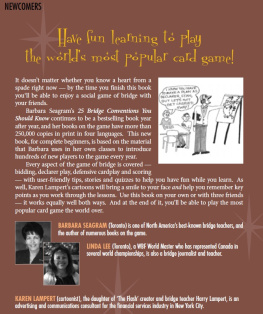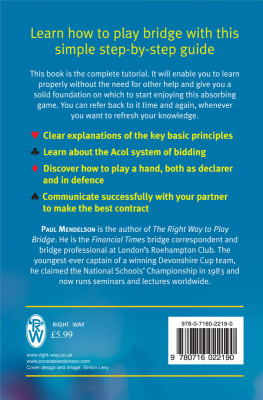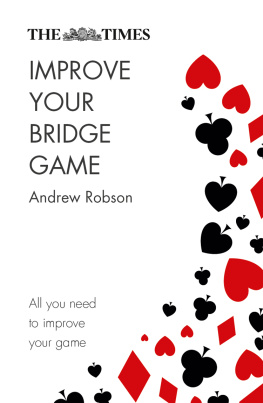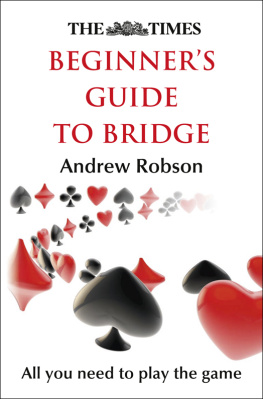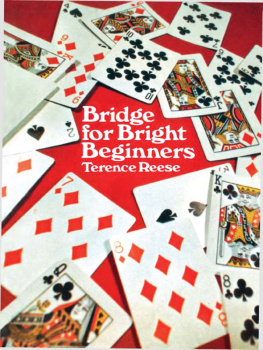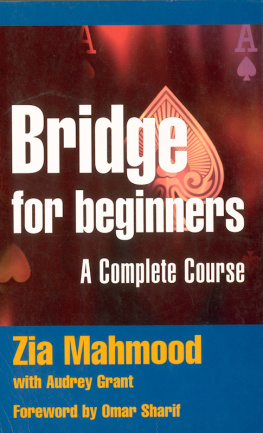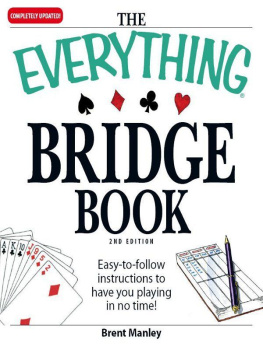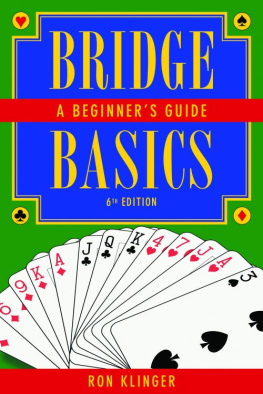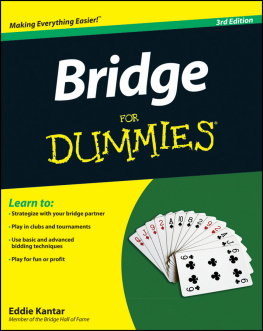Contract bridge is now almost one hundred years old. It has maintained its popularity over all these years because it is a game of unending fascination. It has something for everyone. It is a social game played by four people, so you have a partner to work with and support. It is a game of problem solving. It is a game that you can play for love or for money.
Even if you have never played any card game before, by the time you finish this book you will be ready to sit down and play a friendly game. You will also be able to play bridge online at one of several online bridge-playing communities. Most online sites have teachers who will be happy to work with you to develop your skills. Or you can go to your local bridge club, which may have games every day or be a once-a-week club located in a golf club or recreation center.
Playing bridge does not require much equipment. There are just a few items that you will need: a deck of playing cards, some comfortable chairs and a table. While this book can be used with a teacher in a classroom setting, it is specifically designed to allow you to learn the game at home by yourself or together with friends. If you are going to work through the lessons with some friends, it is best if each of you has a deck of cards to set up the practice deals.
Some readers will be familiar with card games or may even have played some bridge before. If you are among them, you will find Chapter 1 a bit redundant. It contains some information you will already know and moves along quite slowly. Bear with us. Read Chapter 1 anyway at the very least, read the end-of-chapter summary and make sure you know everything it contains. If the concepts are familiar, then move through them quickly. We will soon arrive at material that is new to you.
A final word: dont try to finish the book in a weekend. Take each chapter slowly and carefully. Make sure you understand everything in it before you move on. If you are like us, learning to play bridge will be the start of a lifetime of happy experiences no need to rush!
1 Getting the Idea
DID YOU KNOW?
The earliest known deck of playing cards is from China, and dates from more than 1000 years ago. However, there is some suggestion that playing cards actually originated in India. Ardhanari, a goddess in Hindu mythology, was represented holding in her four hands a wand, a cup, a sword and a ring (for wealth), symbols that appeared almost unchanged on medieval cards. Eventually, these suits morphed into the familiar clubs, hearts, spades and diamonds.
WHAT YOURE GOING TO LEARN
This chapter will introduce you to the basic concepts of the game of bridge. By the end of the chapter, although you will not yet be ready to join a game at your local bridge club, you will understand how the game works. If you have already played similar card games, such as euchre or whist, you may find that this chapter moves slowly. We suggest that you skip over any parts that you find boring and advance to the sections that are new to you.
We will start at the very beginning how to deal out the cards. You are then going to progress through all of the major aspects of the game. You will find out about the auction where players bid to decide the goal for each deal. You will then learn about the different roles players take on during the play of the cards defender, declarer and dummy (dont worry, the name isnt personal!). You will be guided through the play of a bridge deal. You will discover the concept of trumps and have a chance to try your hand at the two types of bridge contracts, trump and notrump.
You will also learn a little about scoring, because it will factor into some of your decisions during the auction. Scoring will be explained in more detail in later chapters.
How to Play Bridge
Welcome to the wonderful world of bridge! Bridge is a social game played among four people sitting around a table. If there are four of you starting out together, introduce yourself to the person sitting across from you. Bridge is a partnership game and the person across the table is your partner, someone to be respected and nurtured. The people on either side of you are your worthy opponents.
In bridge, it is usual to use the compass directions to talk about the four players around the table. Were going to do that in this book. It might be helpful to create a guide card. Draw this diagram on a piece of paper:
Dont worry about placing the guide card so that North faces the real North pole. (The actual geography doesnt matter.) If you are following this chapter in a group of four, then you should be sitting at one of the four compass points. That means that North and South are partners, and East and West are partners. If you are reading this by yourself, then we are going to suggest that you arbitrarily consider yourself to be South. From now on, when we show hand diagrams, we are going to refer to each player by their direction.
Trick"
During the play, each player in turn, going clockwise, places a card face up on the table until four cards have been played.
Pull four cards from the deck and place one face down in front of each player. Starting with East (for now) and going clockwise, each player should put their card face up on the table in front of them. You have just played a trick.
Dealing the Cards
Whoever is designated South should pick up the whole deck and shuffle it. Now deal out all fifty-two cards, face down, one at a time to each player, starting on your left (West) and going clockwise. You will end up placing the last card in front of yourself. All players can now pick up their cards. The collection of cards you are holding is called your

